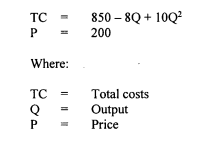TUESDAY: 18 May 2021. Time Allowed: 3 hours.
Answer any FIVE questions. ALL questions carry equal marks.
QUESTION ONE
1. Evaluate four ways in which the government could influence allocation of resources in a country. (8 marks)
2. Explain using formulae, the difference between “arc elasticity” and “point elasticity” of demand. (4 marks)
3. Define the term “Consumer Sovereignty” as used in economics. (2 marks)
Summarise six limitations of consumer sovereignty in an economy. (6 marks)
(Total: 20 marks)
QUESTION TWO
1. Highlight the effects of removing interest rate capping in an economy. (5 marks)
2. Identify four reasons why governments intervene with the operations of price mechanism. (8 marks)
3. Outline seven factors that influence the elasticity of supply of a commodity. (7 marks)
(Total: 20 marks)
QUESTION THREE
1. Using indifference curve analysis, demonstrate how an individual’s equilibrium point is attained. (4 marks)
2. With particular interest on inferior goods, use the indifference curve analysis to demonstrate and explain the income and substitution effect of a fall in price. (6 marks)
3. Kenya, which is currently ranked as a developing country, came up with an economic blueprint geared towards realising economic development by the year 2030.
Required:
Describe five factors that might hinder Kenya from realising the above objective. (5 marks)
Outline measures, that might be put in place in order to overcome the impediments in (i) above. (5 marks)
(Total: 20 marks)
QUESTION FOUR
1. Examine six causes of a deflationary gap in an economy. (6 marks)
2. Define the term “monetary policy”. (2 marks)
Explain five objectives of monetary policy in art economy. (5 marks)
3. Assess seven reasons why developing countries are concerned about the high rate of unemployment in their countries. (7 marks)
(Total: 20 marks)
QUESTION FIVE
1. The total cost and demand functions of a firm operating under monopolistic competition are represented as follows:

Required:
Fixed cost function. (1 mark)
Variable cost function. (1 mark)
Average cost function. (1 mark)
Marginal cost function. (2 marks)
Marginal revenue function. (2 marks)
The level of output at which the firm breaks-even. (3 marks)
2. Examine five reasons for deteriorating terms of trade for developing countries. (10 marks)
(Total: 20 marks)
QUESTION SIX
1. Describe the term “economic integration”. (2 marks)
Highlight six factors that limit successful economic integration in developing countries. (6 marks)
2. Examine four advantages of currency devaluation to a country’s economy. (8 marks)
3. With the use of a diagram, illustrate the optimal point of a firm. (4 marks)
(Total: 20 marks)
QUESTION SEVEN
1. Enumerate seven roles of commercial banks in an economy. (7 marks)
2. With a well labelled diagram, illustrate the concept of economic rent. (5 marks)
Explain how economic rent might be used as a good base for taxation. (3 marks)
3. With the aid of a diagram distinguish between “actual economic growth” and “potential economic growth”. (5 marks)
(Total: 20 marks)